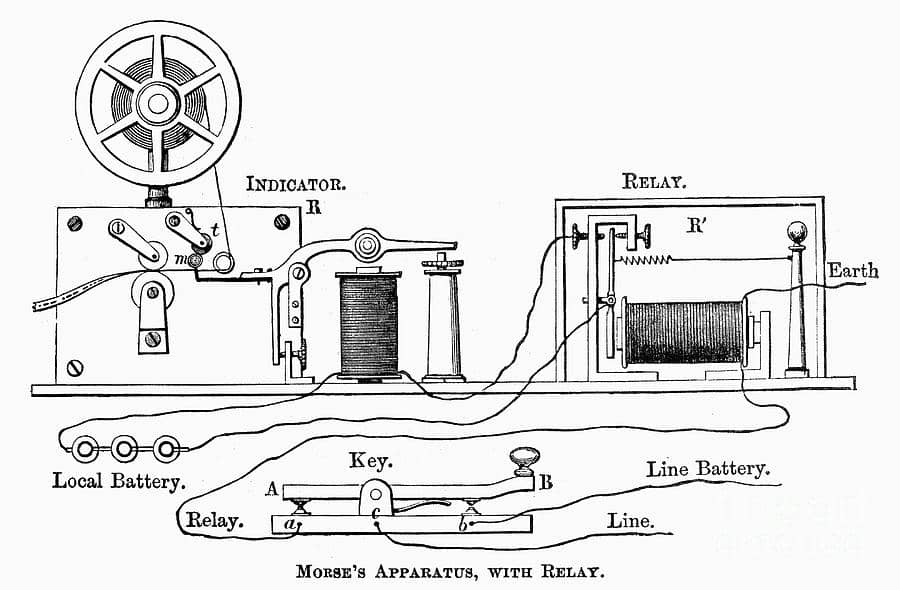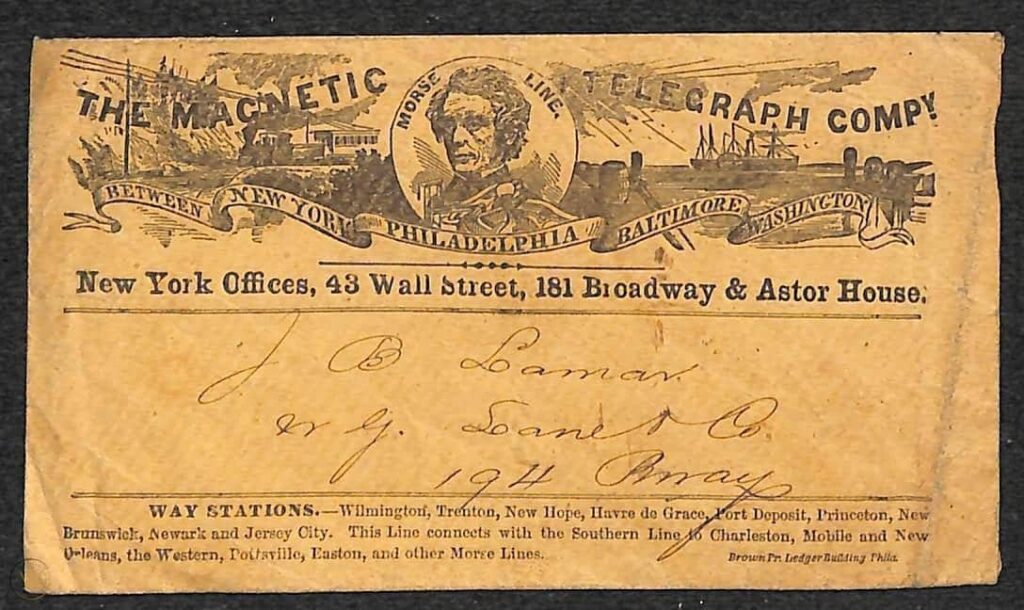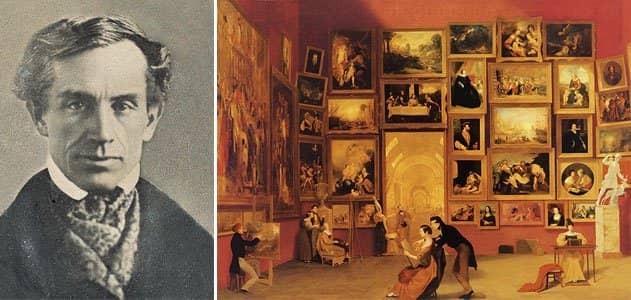A scientist named Joseph Henry and a machinist/inventor named Alfred Vail invented the telegraph that transformed the world. Samuel Morse put their ideas together and gained the fame and the profit.
Morse didn’t do it for money, however. His inspirations were a strange brew of ego, tragedy and xenophobia. How could ego, tragedy and xenophobia lead to Samuel Morse gaining all the fame for this transformative invention? Well, I’ll tell you in this short video.
Table of Contents
Samuel Morse Early Life
Morse and his History with the Electrical Telegraph
Vail and his Morse Code
The Magnetic Telegraph Company
Morse and his struggles
References
Samuel Morse Early Life

Samuel Finley Breese Morse was born to an upper crust family in Charlestown, Massachusetts and had two unconnected passions: painting and xenophobia, both of which, in a roundabout way, led him to his interest in the electric telegraph. Let’s start with painting. Morse went to the finest schools, Exeter and Yale, and got extra cash from doing small portraits of his classmates. After graduation he moved to Europe to study painting.
Well, not really study as much as pontificate on his genius at painting. He wrote his mother that it wasn’t enough to be a portrait painter, no, he wanted to “revive the splendor of the fifteenth century; to rival the genius of a Rafael, a Michelangelo, or a Titian.” Morse was accepted into the Royal Academy of Art and painted with more or less success in England and in America, mostly as a portrait painter.
This is when tragedy struck. In 1825, Morse got a commission to travel to paint a portrait of the American Revolutionary hero Lafayette visiting from France. While working on this portrait, Morse received the news by mail that his young wife had fallen ill. Although he immediately traveled to see her, it was too late and she had already passed away. This tragedy was Morse’s first stimulus towards finding a faster way to communicate.
Meanwhile, Morse continued to paint and remarried. He also worked on his other great passion, a virulent hatred of Catholics and Catholic immigrants. He began writing pamphlets, “giving proofs of a serious foreign conspiracy against the government.” The conspiracy was, according to him, that Catholics were taking over and ruining the country and should have their schools closed and be restrained from running for office or even voting.
In 1836 he ran for Mayor of New York on a “Nativist” ticket, which was just straight up racist. He won less than 4% of the vote, which, to him, just proved the truth of the power of conspiracy of the Catholics.
Morse and his History with the Electrical Telegraph

Morse decided what was needed was for good Protestants to have a way to communicate quickly to help them thwart the awful menace of the Catholics. He thought that an electric method of communication, or the electric telegraph, might be just the thing as long as it was only in the hands of “good” Protestants. In 1832, on a boat ride from Europe, Morse was talking to another passenger on board about Benjamin Franklin and electromagnets was inspired to think of an electrical telegraph where the electricity moved something electromagnetically as a signal.
Morse didn’t know that he wasn’t the first to have this idea. The electromagnet had been invented seven years earlier when an Englishman named William Sturgeon determined that if you wrapped a wire around an iron bar, the bar would act like a magnet could magnetically attract certain metals.
Because the electricity made the iron act like a magnet, it was called an electromagnet. Since that time, people had been trying to use this idea as an electromagnetic telegraph. In fact, it seemed like everyone who heard of the electromagnet wanted to make a telegraph!
In fact, just before Morse went on that boat ride an American scientist named Joseph Henry found that if you insulated the wire and wrapped it very tightly around the iron you could create an incredibly powerful electromagnet (he used it to lift over 2,000 pounds!). Henry also made a smaller electromagnet that he powered with a battery over a mile away.
Henry wrote that his invention would be, “directly applicable for forming an electro-magnetic telegraph.” Now Morse didn’t know any of this because he didn’t think of doing any research. He also had no scientific background. But he did have a lot of hubris, which worked to his advantage.
Anyway, in 1835, Morse got a job as a professor of art at New York University and started to work on his telegraph idea on the side with no success. Morse then contacted a local science teacher named Leonard Gale. Gale was a friend of Henry’s and very familiar with Henry’s discoveries and devices and proceeded to teach Morse how to make an effective electromagnet from his understanding of Henry’s work.
Vail and his Morse Code


By 1837, Morse felt that he had a working model and filed for a patent. He also attracted the attention of a mechanic (and son of the owner of a local iron works plant) named Alfred Vail. Vail was very interested in Morse’s “discovery” and signed a contract to work for Morse and get 25% of the profits. Vail signed that all related patents would be, “taken out in the name and for the exclusive benefit of …Morse”
Vail ended up inventing a telegraph key that worked like a stapler where you pressed it closed a circuit to a battery and when you let go the circuit was broken. Vail also set up the receiver with a spinning paper and coils that would punch a mark in the paper with a pen. If you tapped the key for a second the paper would get a dot, if you held down the key it would leave a long bar, or a dash.
Therefore, Vail made a code where each letter was a combination of dots and dashes. This is commonly called Morse code. Morse himself had a different idea where you would use a convoluted set of numbers that were related to each letter and then a codebook between the two.
The Magnetic Telegraph Company

Meanwhile, Joseph Henry traveled to Europe where he was considered the premier American scientist. When he returned he wrote a friend that he was disgusted to learn of “the charlatanism of our country” specifically from “the Magnetic Telegraph of Professor Morse who first claimed… the entire origin of the project.[i]”
This is why, in 1836, Samuel Morse paid Joseph Henry a visit. Henry explained how all of his devices worked to a very thankful Morse – who then went ahead and patented all of his newly acquired wisdom (and a bit he got from Europe) as his own work! Morse created a new company, “The Magnetic Telegraph Company”, and tried to get the government to give him money to make telegraphs go across the country. Initially, he failed to generate excitement.
He went to England but found too late that two men named William Cooke and Charles Wheatsone had already patented their different telegraph system that involved turning compasses from a distance.
See, the problem with Henry’s telegraph device is that if you made the wires too long, the wires themselves had too much resistance and the current in the coil would be too small to ring the bell (or make a clicking noise like a telegraph did). You could reduce the resistance by using thicker wires but that was expensive and only helped a little bit.
What you really needed was an electric switch every couple of miles that would start a new circuit with a new battery. So, in December of 1835, Henry invented it. It was basically a coil wrapped around a rod where instead of ringing a bell, when it had electricity, it pulled a metal lever to “close” another circuit with another battery. In theory (and in practice) you could setup this over and over again for as long a distance as you wished.
Morse and his struggles

Morse went back to Washington DC, but this time he decided to use bribery. He talked to Francis Smith, a congressman from Maine and the chairman of the House Commerce Committee.
Morse convinced Smith that if the government funded his company, Smith could retire from the government and get a job with him. Smith complied and wrote a bill to give, basically, himself and Morse $30,000 (equivalent to almost 1 million dollars today) to build a telegraph line between Washington DC and Baltimore.
Meanwhile, Henry had traveled to Europe and was disgusted to return to news of Morse’s actions (although he never made any claims in court), “the charlatanism of our country struck me much more disagreeably when I first returned [from Europe]… you probably heard of a great sensation [that] was produced by the Magnetic Telegraph of Professor Morse who first claimed… the entire origin of the project.[ii]” Morse’s company quickly made millions and his code of dots and dashes to mean different letters are still called Morse code.
However, Morse (and Smith) were soon embroiled in lawsuit after lawsuit as people smelled a weakness in their profitable business. Morse had to sometimes come up with clever methods to escape detection, like when his original hand written research “accidentally” was destroyed in a fire just before a patent lawsuit.
Another time he had trouble when he could not describe how his own code worked. Despite all of these lawsuits, Morse retired with a ridiculous amount of money. He then spent his free time arguing (as a Northerner) for the joys of slavery, saying among other things that, “Slavery… [is] divinely ordained for the discipline of the human race.” Ironically, the telegraph increased long distance communication, which increased the influx of immigrants and helped the abolitionists let people know about the horrors of slavery. Morse died in 1872 and is, according to the Yale website, “among the most honored Yale graduates on campus today.”
Meanwhile Henry continued his research first at Princeton then at the newly created Smithsonian Institute. Politically, he went the other way from Morse and became a personal friend of Abraham Lincoln. Supposedly, he didn’t talk about Morse and the telegraph much but he did once say, “If I could live my life again… I might have taken out more patents.”
Morse, “combining and applying the discoveries of others in the invention of the best practical form of the magnetic telegraph”
References
[i]p 83 “Science in nineteenth century America” Reingold
[ii]p 83 “Science in nineteenth century America” Reingold


Pingback: How Heinrich Hertz Discovered Radio Waves - Kathy Loves Physics